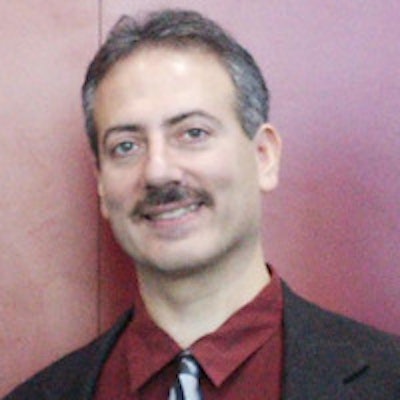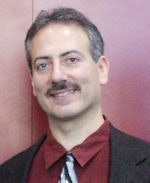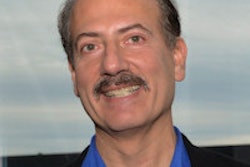
Driven by the development and adoption of next-generation PACS technology, CT image review will be significantly different and smarter in the future, according to Dr. Eliot Siegel from the University of Maryland School of Medicine.
Greater integration of information systems will give technologists and radiologists full access to the patient's medical and imaging record and sophisticated clinical decision-support systems, said Siegel, who is a professor and vice chair of radiology at the University of Maryland and chief of imaging at the Veterans Affairs (VA) Maryland Health Care System.
A wide range of technology advances will be evident in the next generation of PACS, such as an increasing trend toward vendor-neutral archives (VNAs), Siegel said.
 Dr. Eliot Siegel from the University of Maryland.
Dr. Eliot Siegel from the University of Maryland.
This revolves around the concept of "you own your own archive, and the archive is able to support multiple different information systems," he said. "It may also be able to support not only your PACS images but also be able to store images from your modalities in the future."
He spoke during a talk at the recent International Symposium on Multidetector-Row CT in Washington, DC.
There's also going to be increased utilization of the cloud, either via a local cloud within an institution or being able to store images on the Internet, Siegel said.
Smarter communication
Closing the communication loop between radiologists and referring physicians may be the biggest challenge in radiology today. Next-generation systems will not only document notification of clinicians, they will also record receipt of information and then follow up on and track recommendations, Siegel said.
"[We'll be able] to use structured reporting or natural language processing to be able to mine the information so that we can actually follow up on recommendations and on those reports with disclaimers," he said.
In addition, quantitative lesion tracking will allow a computer, in a much more automated fashion, to follow a patient's lesion or lesions over time.
Multiparametric information could be extracted from CT, MR, and other types of studies and cross-correlated with genomic data to predict survival or the best ways to treat patients, he said.
Automated data capture
The automated capture of data from CT images will increase in the next five to 10 years, according to Siegel.
"Every normal CT pulmonary angiogram that we do, for example, that gets reported out as essentially negative contains an incredible wealth of data that we're not reporting in any way," he said.
This might include cardiac chamber size and calcifications; liver and lung texture; size of organs such as liver, spleen, kidneys, and thyroid; aortic size; bone mineral density; compression fractures or loss of height of spine; and prostate size, he said.
"Having a computer be able to automatically segment and report some of those and store that [information], I think that is something we're going to be seeing in the future," he said.
While most users today still use a mouse to interact with PACS, there are much better ways to do it, Siegel said. Researchers have found favorable results, for example, with a jog shuttle wheel and tablet, as well as a five-button mouse.
From advanced visualization to routine
In another trend, Siegel noted that some functions that were previously considered advanced visualization are now becoming routine and mandatory for PACS workstations. These include sagittal images for evaluating the spine, maximum intensity projection (MIP) for pulmonary nodules, and arithmetic summation to allow thick slices to be generated from original thin sections.
Automated image registration between current and prior exams will also be standard on PACS workstations, as will 3D hanging protocols, he said.
Siegel also sees a continuing trend toward server-side rendering for delivering images to the enterprise.
"That means the whole dataset isn't transmitted to your computer," he said. "But just like Google Earth or some of the mapping programs, you can interact with a server and just get a subset of the data, and you will control that at your workstation without having the entire dataset downloaded."
Automated postprocessing
Much of the next-generation CT and MRI technologist postprocessing will be performed by "intelligent" software templates and 3D hanging protocols, enabling technologists to spend more time in patient care and image selection, Siegel said. This will also free up the 3D/advanced visualization technologist to perform increasingly advanced processing and analysis and to help out with repetitive and more mundane processing and visualization tasks.
Radiologists will also be able to receive their continuing education and get credits as part of their workflow at the PACS workstation, he said.
There's also potential to have a host, i.e., a single workstation, support a number of different image viewing applications.
"There's some great work being done by the DICOM Working Group 23 community looking at standard application programming interfaces that would allow you to be able to sit at a single workstation ... to get best-of-breed [applications]," he said.
There will also be more and more zero-footprint applications (typically based on HTML5), allowing a Web browser to function as a PACS workstation and potentially an advanced visualization workstation, Siegel said.
Automated protocols
In the future, automatic CT protocols will be suggested based on the type of examination requested, clinical history, renal function, age, etc. After the radiologist or technologist signs off, these protocols would be directly transferred to the CT console and into the record, Siegel said.
More support will also be added for displaying contrast injection curve and information, he said. The next generation of contrast injectors will be smarter and operate on the network as network appliances.
"If the CT pulmonary angiogram contrast injection was not optimal, it will be able to record that, understand why, and minimize the likelihood that it happens if the patient comes back again," he said.
The sharing and exchange of images in an electronic format will continue to increase, according to Siegel.
"In the next generation of PACS, images will be able to be transferred directly from one PACS to another, and patients will be able to access their own images in the cloud," he said.
Finally, there will be an increase in the application of artificial intelligence software, such as being able to synthesize an electronic medical record's data for the radiologist or technologist looking for that information, Siegel said. Other capabilities could include the ability to provide advanced decision support based on information in the electronic medical record.




















